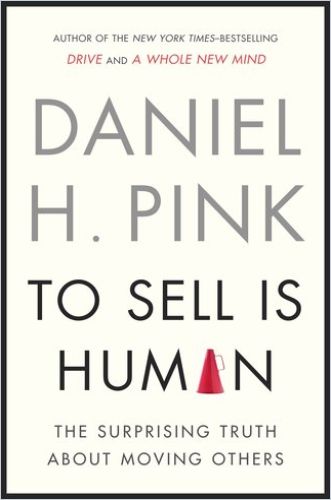Daniel Pink sets out to construct “a broad rethinking of sales as we know it.”

We’re All In Sales
Daniel Pink is the best-selling author of Drive and A Whole New Mind. His books have been translated into 34 languages, and his groundbreaking thoughts and guidance are known worldwide. During a break after finishing a book, Pink carefully charted all his activities over a two-week period. He was surprised to discover that, by any objective measure, the way he spent his time proved he was a salesman. In those two weeks, he pitched a magazine article, sought a new seat on a plane and dealt with his colleagues, all in pursuit of “resources other than money.”
When I stepped back to assess this welter of information – a pointillist portrait of what I do and therefore, in some sense, who I am – the picture that stared back was a surprise: I am a salesman.Daniel Pink
Struck by this revelation, Pink offers an overview of today’s world in which you and everyone else sell constantly. You also engage in “nonsales selling” when you offer ideas or actions that don’t bring you immediate profit. Sometimes you sell yourself or your skills or your views. He examines what sales mean now and in the future.
Charm and Insight
Pink states his propositions plainly and simply. His authorial voice communicates good will. And for all his considerable intelligence, Pink doesn’t talk down to his readers or trumpet his expertise. He has a folksy, unpretentious style. However, his continual presentation of himself as just another busy dude who stumbled onto something new and exciting can get a little tiresome, and he can become downright annoying when he launches ideas that seem unrealistic.
The only thing you’ve got in the world is what you can sell. And the funny thing is, you’re a salesman, and you don’t know that.Arthur Miller, “Death of a Salesman”
But on the whole, Pink’s charm makes him readable, credible and memorable; after all, his other books have sold more than a million copies in the US alone. In foundational but not wholly original advice, Pink urges salespeople to remember that “honesty, directness and transparency” produce higher-yielding long-term customer relations. He posits that the “natural” salesperson either doesn’t exist or is irrelevant or both, “in part because we’re all naturally salespeople.” Lifelong social interaction only enhances your sales skills.
ABC
Alec Baldwin’s incendiary speech to a group of salesmen in the film Glengarry Glen Ross exemplifies old-school sales thinking. Speaking the words of playwright David Mamet, Baldwin reminds the salesmen to “A – always. B – be. C – closing.” For decades, this has been the main idea drilled into every salesperson. But it worked only when clients had fewer options and salespeople held all the data.
As Pink shows with clear examples, the end of this “information asymmetry” transforms sales. Now that buyers have infinite choices and may know more about products and features than many salespeople, Pink offers a richer, more contemporary ABC.
Attunement, Buoyancy and Clarity
Attune yourself to those around you and to the people you’re pitching. Connect more to empathy than to power. Pink advises trying to assume the perspective of the person with whom you’re dealing rather than trying to impose your perspective. Use “strategic mimicry” to mirror your counterpart’s posture, speaking rhythms and “mannerisms.” If the other person scratches an ear or puts an elbow on the table, do the same, but “subtly enough” so you aren’t seen to be mimicking.
Remain positive and make “positivity-inflected” pitches. Positivity includes “amusement, appreciation, joy, interest, gratitude and inspiration.” The prospects you’re pitching can read those aspects in your character and manner. And they can certainly perceive the absence of them. Pink directs you to embrace your positive emotions and to let the other person fuel how you make your pitch.
We are engaged in…‘non-sales selling.’ We’re persuading, convincing and influencing others to give up something they’ve got in exchange for what we’ve got.Daniel Pink
He also notes that an “optimistic explanatory style” is far more effective than a neutral tone. Productive salespeople understand more than solving problems. They have the clarity of mind and vision to recognize a client’s problem, even when the client can’t. To induce clarity in clients, offer fewer choices, since that usually leads to a greater likelihood of a purchase.
Pink makes a decent case for his ABC ideas, and his studies clarify them. His argument that these mind-set changes will make you a better salesperson than if you just stick to the original ABCs aren’t as evidence-based as the knowledge that they’ll make you more content and mindful.
Beyond the “Elevator Pitch”
A salesperson must be able “to pitch, to improvise and to serve.” Improvisation – as opposed to studied sales scripts – matters in a complicated sales setting without a predictable ending. Pink bases his sales improvisation, like improv theater, on listening carefully, making the other person look good and responding “yes, and” to invitations to keep the discussions going. He moves service beyond treating customers well and urges making a “personal and purposeful” difference.
Actually believing in what you’re selling has become essential on sales’ new terrain.Daniel Pink
Pink cautions that your pitch is never “the last word.” An effective pitch doesn’t try to convert your audience. It draws listeners into a two-way, engaged conversation. Dale Carnegie, author of the 1936 evergreen bestseller How to Win Friends & Influence People, urged having a prepared “elevator speech” so you can easily tell anyone your tasks, your purpose and why you matter. Pink takes a different direction, because, he says, the elevator pitch is no longer applicable. Open offices, he reported pre-pandemic, render it unnecessary. You don’t have to wait for an elevator ride to chat with the CEO. He says that nowadays you can just walk over and say hi. Email, cellphones and websites offer many opportunities to pitch, but your audience has less attention to spare.
Six Pitches
Handling audience distraction is a recurring theme in contemporary business books. Pink insists that modern times demand modern pitches. He offers six potential models – some more convincing than others.
First, Pink suggests a “one-word” pitch – based on a term that suits your product or idea. He claims Barack Obama constructed his 2012 presidential campaign strategy around the single word: “Forward.” Pink offers expert quotes to support this idea, yet “forward” is the one example he offers. Many counterexamples come to mind.
Second, for his “question” pitch, Pink cites Ronald Reagan’s 1976 presidential campaign query. Reagan asked: “Are you better off than you were four years ago?” People hear declarative statements “passively,” but they engage with questions. A question, Pink argues, compels you to create reasons to agree. This advice – also given with just one example, and this one from decades ago – does little to help nurture an understanding of how to create your own question pitch.
We’ve moved from a world of caveat emptor, buyer beware, to one of caveat venditor, seller beware – where honesty, fairness and transparency are often the only viable path.Daniel Pink
Pink also returns to the thrilling days of yesteryear to offer his third pitch, the “rhyming” pitch. He cites Johnny Cochran’s dictum to the O.J. Simpson jury about the infamous black glove: “If it doesn’t fit, you must acquit.” This is a weak idea: you probably recall Cochran’s rhyme because it was an act of singular genius. The public has embraced few notable rhyming slogans since.
You want people to read your emails, but capturing their eyeballs requires a potent “subject-line” pitch. Pink’s worthwhile, practical advice is to write a specific, clearly utilitarian or “mysteriously intriguing” subject line. Usefulness and “curiosity” are the most effective triggers for helping people cut through email clutter. This time, Pink offers illustrative examples. His fifth variant, the “Twitter” pitch, works when you ask questions, offer data or provide “useful information.”
The “Pixar” Pitch
The sixth type, the Pixar pitch, comes from Emma Coats, a former Pixar Animation Studios story artist. It consists of six fill-in-the-blank sentences that form a pitching paragraph: “Once upon a time… Every day… One day… Because of that… Because of that… Until…” You can put almost any narrative into those sentences and hold your audience’s attention.
Between 2000 and today, the very period that broadband, smartphones and e-commerce ascended to disintermediate salespeople and obviate the need for selling, the total number of sales jobs increased and the portion of the US workforce in sales has remained exactly the same: one in nine.Daniel Pink
For example, you can see the Pixar short form structure at work in the animated film Finding Nemo: Once a fish told his son not to swim into the sea. One day, the son swam away. Because of that, his dad pursued him. Because of that, the dad ended up in an aquarium…until his son rescued him. Try reciting what you did today, like going to dinner, giving each item a sentence, up to your closing “until.” Notice how your day becomes a compelling drama when told using this framework.
The Pixar pitch is the one truly valuable new pitch model Daniel Pink recommends. Using its prompts, you can add excitement as well as suspense to a pitch for any product, including yourself. As he points out, “Whether it’s selling’s traditional form or its non-sales variation, we’re all in sales now.”
Daniel Pink’s other books include The Power of Regret: How Looking Backward Moves Us Forward; When: The Scientific Secrets of Perfect Timing; Drive: The Surprising Truth about What Motivates Us; and A Whole New Mind: Why Right-Brainers Will Rule the Future.












